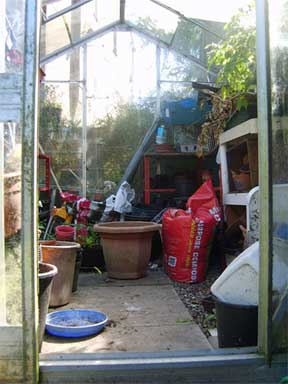Most indoor house plants are just southern plants brought north of their hardiness range. Everyone who has traveled in the South knows the spectacular bougainvillea which produces veritable floral fireworks as it billows over porches, roofs and fences. A careful look shows that the color is in a set of bracts surrounding a cluster of insignificant trumpet-shaped flowers.
The fastest-growing, magenta-flowered, smooth-leaved form is probably Bougainvillea glabra. There are now many hybrids in brilliant and pastel colors of crimson, orange. tangerine and even white.
Bougainvillea can be grown in pots or tubs, or over stakes, frames or trellises. I prefer to plant it in a large tub or in the ground and train it up on the rafters where it feels at home and rewards the gardener.

A continuous campaign against mealy bugs is required, especially if chemicals cannot be used. The falling bracts must be picked up from shelves, benches and plants and the vine must be kept to the desired limits by drastic pruning. In summer its rampant growth is helpful in shading other plants. Cuttings taken in late summer from small half-ripened wood are easily rooted in sand.
Serving as the Outdoor Garden
This month the greenhouse serves the outdoor garden by harboring up near the glass flats of annual seedlings; begonia tubers; gladiolus; tuberoses; acidanthera; sprouting dahlia tubers to supply cuttings; cuttings from stock plants that have been carried over such as coleus, iresine, impatiens, dusty miller (centaurea), mint and rose geraniums, pineapple-sage, geranium, fuchsia and heliotrope. Will planting out weather come and save our life before the bursting point is reached? Oh for that elastic greenhouse!
During the month of April – at this time the coldframe is of great value. Many flats of spaced or potted seedlings sojourn there, relieving the congestion indoors. As they grow, and the weather approaches planting out temperature, the little plants are “hardened off,” with the gradual opening of the frame each day. This eases the shock of transition and makes them better able to survive when set out.
Landscape planning affects a greenhouse owner’s life in two ways.
First: The greenhouse, either as part of the house or away from it, is beautiful in form, with its slender framework and attractive appearance from the outside-frosted glass in winter and cool looking shaded glass in summer. The greenhouse, by proper planting and use of walls and terraces, can be made an integral part of the outdoor garden.
Second: The sophisticated greenhouse amateur finally reaches a stage at which he “landscapes” his planting under glass. The main purposes are to utilize sunlight and space to the utmost and to grow large old specimen plants of beauty and interest. The great show houses of the botanical gardens notably the duPont Longwood Gardens at Kennett Square, Pennsylvania actually have classical formal gardens under glass, with lawns and flowering trees and shrubs. The Coe Hall at Planting Fields, Long Island, are notable for their camellia lined walks. A high arched house has rare flowering vines on each arch. These sights are the amateur’s dream as he packs his plants three layers deep in his tiny greenhouse.
Loving the Light
Vines up near the glass, flats of seedlings or sun-loving cacti and succulents are line shade for hanging pots of orchids, ferns and trailers, and racks of exotics and rex begonias. Great ingenuity can be shown in the effort to create the necessary conditions for more species of plants, but the overall effect of beauty should never be slighted in this quest.
